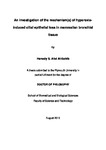An investigation of the mechanism(s) of hyperoxia-induced cilial epithelial loss in mammalian bronchial tissue
| dc.contributor.supervisor | Moody, John Jr | |
| dc.contributor.author | Abd Al-Sahib, Hanady | |
| dc.contributor.other | Faculty of Science and Engineering | en_US |
| dc.date.accessioned | 2013-09-10T08:06:54Z | |
| dc.date.available | 2013-09-10T08:06:54Z | |
| dc.date.issued | 2013 | |
| dc.identifier | 10211752 | en_US |
| dc.identifier.uri | http://hdl.handle.net/10026.1/1613 | |
| dc.description.abstract |
Hyperoxia is an essential aid to life support in patients with severe respiratory failure. However, it is recognised as a contributor to the pathological consequences of oxidative stress including oxidative tissue damage, inflammation and cell death resulting in acute or chronic lung injury. The specific mechanisms behind this type of injury are still not completely understood. This study was undertaken with two main aims. Firstly, to evaluate the adverse effects of hyperoxia on the ciliary coverage using a novel large animal model. For the first time, an in vitro bronchus bovine tissue culture model was developed and used to quantify ciliary coverage loss over time. The protection role of antioxidant supplementation with α-tocopherol and ascorbate was also investigated. Secondly, the importance of the tight junction protein ZO-1 in hyperoxia-induced monolayer permeability was investigated using a human bronchial cell line (16HBE14o-) and the potential inflammation effects on bronchial tightness. Additionally studies were carried out in order to find out if antioxidant vitamin treatment can protect against or reduce these effects. Scanning electronic microscopy indicated that hyperoxia caused a time dependent decline (t½ = 3.4 d compared to 37.1 d under normoxia) in ciliary coverage (P < 0.0001). This was associated with an increase in the number of sloughed cells, many apparently intact, into the medium (p < 0.05). Several biochemical parameters were assessed to obtain evidence of oxidative stress caused by hyperoxia in this model including tissue damage (lactate dehydrogenase, LDH, in the medium), lipid peroxidation (thiobarbituric acid reactive substances, TBARS), DNA damage (comet assay used for the first time with primary bronchus culture), protein oxidation (OxyBlot kit) and antioxidant status (total glutathione). Antioxidant vitamins had a significant protective effect on the hyperoxia-induced reduction in percentage ciliary coverage (P < 0.05). Moreover, an increase in the bronchial permeability was shown characterised by a significant decrease (P < 0.05) in transepithelial electrical resistance (TER) under hyperoxic conditions. The reduction of ZO-1 associated fluorescence (P < 0.01) is in compatible with the downregulation of ZO-1 expression assessed by RT-PCR. Levels of the pro-inflammatory cytokines IL-8, IL-6 and TNF- concentration in the medium, as measured by ELISA, increased significantly (P < 0.001) under hyperoxia, and this was accompanied with a marked increase in the cytokine expression. However, the antioxidant vitamins E and C, partially reduced the impact effects of hyperoxia, both individually and in combination, whilst increases in ZO-1 expression and fluorescence intensity (P < 0.05), as well as the suppression of cytokine secretion and gene expression was modest. Use of these vitamins was not enough to reduce the epithelial permeability significantly compared to normoxia. The data implies that hyperoxia-induced damage to cultured bovine bronchial epithelium and the denudation of cilia over time with increased permeability was due, at least in part, to the decline in TJ protein expression and associated fluorescence intensity. The antioxidant vitamins vitamin E and C had partial protective effects against hyperoxia damage. However, additional studies are called for in order to further understand the possible associations between oxidative stress and inflammation caused by hyperoxia and tight junction proteins, also response to treatment with antioxidant individually or in combination. | en_US |
| dc.description.sponsorship | Ministry of higher education and scientific Research/Republic of Iraq | en_US |
| dc.language.iso | en | en_US |
| dc.publisher | University of Plymouth | en_US |
| dc.subject | Oxidative stress | |
| dc.subject | Cilia | |
| dc.subject | Zona occludens-1 | |
| dc.subject | Hyperoxia | en_US |
| dc.title | An investigation of the mechanism(s) of hyperoxia-induced cilial epithelial loss in mammalian bronchial tissue | en_US |
| dc.type | Thesis | |
| plymouth.version | Full version | en_US |
| dc.identifier.doi | http://dx.doi.org/10.24382/3426 |
Files in this item
This item appears in the following Collection(s)
-
01 Research Theses Main Collection
Research Theses Main


